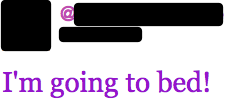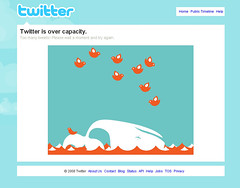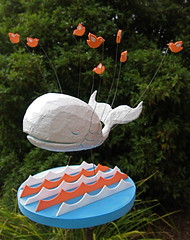*In this case, these “rules” are not unlike the “Pirate Code” from a popular movie series. They’re guidelines, meant to be followed when it’s convenient for you. For the most part, they’ve been convenient for me.
With the advent of Google+ there are a lot of people thinking (and not thinking) about how to properly use a social network. The typical behavior when a new network is discovered is to dive in headfirst and find every person you’ve ever known that’s currently using the service.
This is completely normal. It’s akin to showing up at your class reunion and scanning the room for familiar faces. You don’t want to be the awkward person that’s all by yourself, after all.
What’s not such a good idea is what brings me to my first rule:
1. Don’t follow everyone!

 While the top image is relevant to this rule, the bottom one is even more telling. Mr. Dembo‘s a very smart person with a lot of Web 2.0 savvy and a job that centers around community building. He could theoretically surf social networks in his office and honestly say that’s part of his job description. If he says something is too much, it’s too much.
While the top image is relevant to this rule, the bottom one is even more telling. Mr. Dembo‘s a very smart person with a lot of Web 2.0 savvy and a job that centers around community building. He could theoretically surf social networks in his office and honestly say that’s part of his job description. If he says something is too much, it’s too much.
If you want a social network to be social and not just a noise machine, there is a definite limit to how many people you can follow and still have a conversation. On Twitter (the social network I’ve spent the most time on, historically), my personal limit is somewhere between 50-100 people depending on how active they are and how much time I have to read posts. Your own mileage may vary, but when I see someone following over 100 people I begin to seriously doubt that they could be following any of the conversations.
Of course you can still use your network as a megaphone to broadcast things, but that just requires more people to follow you – not the other way around.
2. Have more followers than you follow!


Minecraft creator Notch is doing things right, at least by my standards. The mystery person… not so much.
A good social network is an asynchronous one. With the exception of a newly created account, you should always have more people interested in what you have to say vs. the other way around. Following a grossly disproportionate number more than you have following you – particularly when it’s over 100% or 100 followers more – makes it seem like you’re playing the numbers game.
What’s the numbers game? That’s when you’ve decided to treat your social network like a game and your follower count like a high score. A “cheap” way to get that number up is to break Rule # 1 and follow everyone you can. A percentage of those will follow you back out of gratitude. You then unfollow everyone and repeat the process until you’re happy with how many people are following you.
(Except they’re not really following you, because if they follow everyone who follows them then they will quickly have all meaningful conversation drowned out by noise and spam.)
If you see someone like the censored picture above, chances are they’ve no interest in what you have to say. Following them is a waste of your time and a reinforcement of their negative behavior. I tend to block people like that.
3. Block people!

The above account was also following 18,514 people at the time I took the screenshot. It started following me while I was writing this post, and I blocked it before I took that screenshot.
There seem to be a lot of people who feel the “block” feature on a social network is meant for accounts that are vile, profane, or promote illegal activities.
It is.
It’s also useful for helping to police social networks. Any network that’s reached a “critical mass” of users is far too large to be adequately regulated by that network’s paid staff. They have to crowd-source that responsibility to their user base.
There’s a reason why Twitter has a “Report Spam” option. It acts the same as the “Block” option, except that if enough people report that account the staff will look into it to see if it should be shut down.
Don’t be content to allow spammers to follow you. Report/block them, and you’ll end up helping to make that social network a better place – one click at a time.
4. Follow interesting people!


(Which of these two accounts do you think might be more interesting? I know which one I’d pick.)
OK, enough about not following – let’s talk about who to follow – me!
Just kidding.
Who you follow is totally subjective and depends on only one person: you. Life is too short for you to spend all your time scrolling past posts that don’t hold your attention. Every person you follow should be interesting to you. Frequent posts about mundane activities (I’m going to bed! I’m getting sandwich! I’m studying!) might be interesting to you if you are particularly close to that person, but if you’re not, they’re noise.
Follow people who frequently post things that make you sit up and take notice.
5. Post things that are interesting to you.

Yes, I finally caved in and posted a screencap of my own posts. Relevant, I guess….
Chances are that if you want to actively participate in a social network, you want to find people who have interests similar to your own. If you post things that you think are interesting, the (non-spammer) people who follow you will most likely be interested in the same things. It’ll take a while for the network to build up, but it will build up.
And you won’t have to agonize over what to post next or whether or not something will make you lose followers, because they’re already following you for being you.
Hopefully, being you comes naturally.
-=-=-=-=-=-=-
I don’t assume that all these rules apply to everyone. They’re my rules that I’m trying to follow myself. That said, I’ve found them to be very helpful to me.
If you’re testing the waters of social networking – or you feel like you’re drowning in the deep end – perhaps some of these might work for you as well.
(And should you decide I’m interesting, perhaps you might want to follow me on Twitter or Google+. Only if you want to, of course.)





